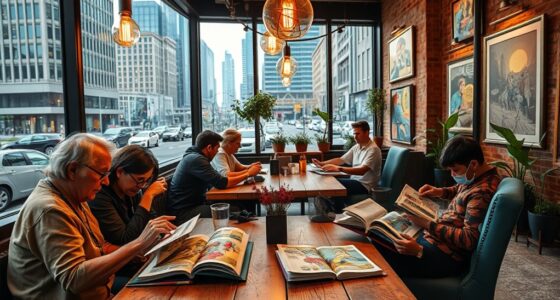Advertising’s coffee narratives effectively connect with your morning routines by showcasing coffee as more than just a beverage — it’s a comforting, energizing ritual that reflects your personal identity. They use storytelling, sensory cues, and aesthetic visuals to create emotional bonds and embed themselves into your daily life. These ads turn simple moments into meaningful rituals, making coffee feel like an essential part of who you are. Keep exploring to discover how brands craft these powerful connections.
Key Takeaways
- Coffee ads craft stories that position the beverage as an essential part of morning routines, fostering emotional connections.
- Visual and sensory branding in commercials evoke warmth, comfort, and energy associated with morning rituals.
- Narrative elements highlight the ritualistic and artisanal aspects of coffee, reinforcing its role in daily life.
- Advertisements use relatable scenes like sunrise and cozy kitchens to embed coffee into viewers’ morning experiences.
- Storytelling in coffee ads strengthens brand loyalty by aligning with personal identity and daily habits.

Coffee advertising has long been a powerful tool for shaping how we perceive and connect with our daily brew. When you watch a commercial, you’re often transported into a world where coffee isn’t just a drink—it’s an experience that symbolizes comfort, energy, and even identity. Brands use storytelling to craft a narrative that resonates with your personal routine, making that morning cup feel like an essential part of your life. They don’t just promote the product; they tell a story that aligns with your values, aspirations, and daily rituals. This approach, known as brand storytelling, creates a deeper emotional connection, making you more likely to seek out that brand every morning. It’s about more than just the coffee; it’s about the story you want to be part of, whether it’s a moment of calm before a busy day or a burst of energy to conquer your tasks. Effective use of sensory branding, such as visuals and sounds, further immerses viewers, making the experience more vivid and memorable. When you see a commercial showcasing a steaming cup of coffee, you’re not just watching; your senses are being engaged. The visuals of rich, dark coffee swirling in a mug, combined with the warmth of a sunrise or the cozy ambiance of a kitchen, evoke feelings of comfort and familiarity. Sound design also amplifies this sensory experience—think of the gentle pour, the satisfying sip, or the crackling of a morning fire. These sensory cues make the experience more tangible, pulling you into the scene and making the idea of that coffee feel more real. As you watch these ads, your mind begins to associate specific sensory elements with the brand, reinforcing your desire to recreate that feeling with your own cup.
Advertising’s coffee narratives are carefully crafted to embed themselves into your daily routine. They create a sense of belonging, a story that you want to be part of every morning. Whether it’s emphasizing the artisanal process or highlighting the energizing effect, these stories tap into your subconscious, making your choice of coffee more about the narrative than just the beverage itself. As a viewer, you’re encouraged to see yourself as part of that story—someone who values quality, tradition, or simply the simple pleasure of that first sip. Utilizing wall organization and aesthetic presentation in product advertising can evoke a sense of order and style that resonates with consumers. Through compelling brand storytelling and sensory branding, coffee ads do more than sell a product; they sell a ritual, a moment of connection, and a story that starts with you and your morning.
Frequently Asked Questions
How Do Coffee Commercials Influence Consumer Behavior?
Coffee commercials influence your behavior by shaping your perceptions and creating emotional connections. They use branding strategies that associate coffee with comfort, energy, and daily routines, making you more likely to choose a specific brand. These ads tap into your subconscious, influencing your preferences and purchase decisions. By portraying coffee as essential to your morning, they effectively encourage you to see it as a crucial part of your daily life.
What Cultural Differences Are Reflected in Coffee Advertising?
Did you know that 65% of consumers say cultural symbolism influences their coffee choices? You’ll notice that advertising often highlights ritual significance, reflecting cultural differences. For example, in Italy, coffee is a quick social ritual, while in Japan, it symbolizes precision and craftsmanship. These ads mirror local values and traditions, making you feel connected to a broader cultural identity through the coffee you enjoy.
How Has Digital Media Changed Coffee Marketing Strategies?
Digital media has transformed your coffee marketing by enabling brands to build stronger loyalty through interactive content and personalized experiences. You’re likely to notice sensory branding that appeals to your senses, creating a more immersive connection. Social media campaigns foster community and engagement, making it easier for brands to keep you interested and loyal. This shift allows for real-time feedback and targeted advertising, deepening your overall brand relationship.
What Role Do Storytelling Techniques Play in Coffee Ads?
Imagine you’re in a medieval tavern, yet today’s coffee ads use archetypal storytelling to connect emotionally. You see a visual narrative that depicts comfort, energy, and community, making the product relatable. These techniques create a powerful bond, turning simple coffee into a symbol of morning routines. By tapping into universal themes, your favorite brands craft memorable stories that resonate deeply, encouraging you to start your day with their brew.
Are There Ethical Concerns in Portraying Coffee Consumption?
You should be aware that portraying coffee consumption can raise ethical dilemmas, especially around advertising honesty. Some ads might exaggerate benefits or create unrealistic expectations, which can deceive viewers. It’s important to contemplate how these portrayals influence consumer perceptions and whether they promote responsible messaging. By maintaining honesty and transparency, you help avoid ethical pitfalls and build trust with your audience.
Conclusion
As you watch those morning coffee ads, remember they’re crafting more than just a drink—they’re brewing a story you want to be part of. Think of it like waking up to a warm, familiar scent that pulls you from sleep, promising a fresh start. Just like that first sip, these narratives awaken your senses and set the tone for your day. So next time, see beyond the screen and savor the story they’re pouring out.









